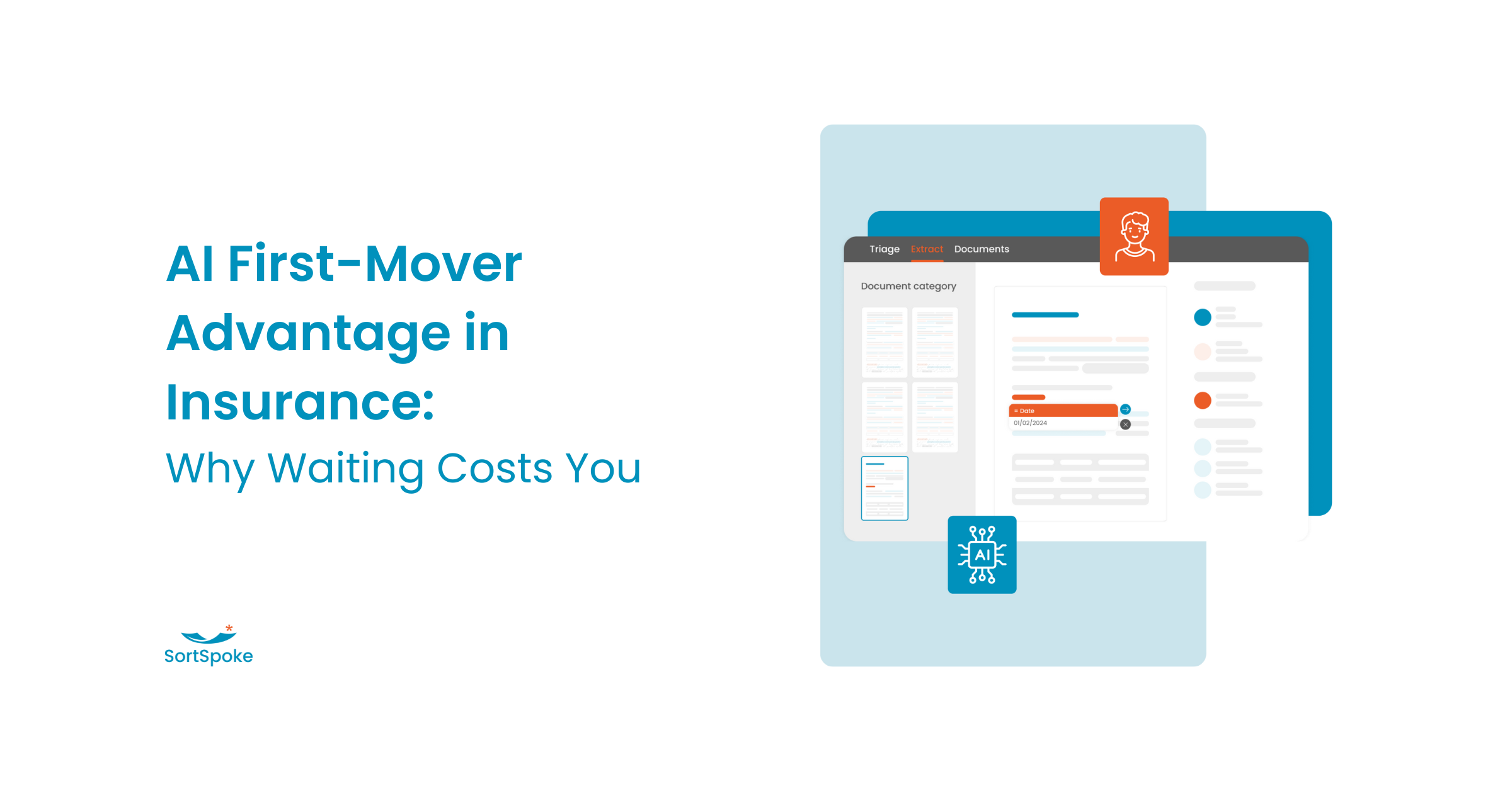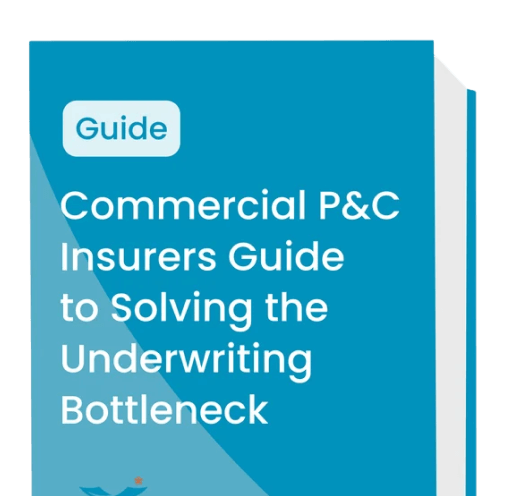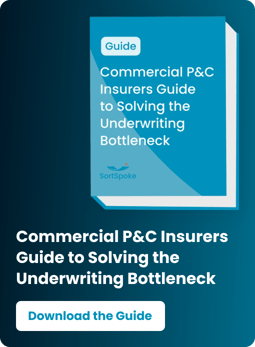
AI First-Mover Advantage in Insurance: Why Waiting Costs You
TL;DR
- AI has reached critical mass in insurance: Two-thirds of executives now prioritize AI—up from just 17% in 2021—making this the moment when competitive gaps begin to widen
- The first-mover advantage is real: Industry experts warn that waiting for complete regulatory clarity or zero-risk conditions may create "insurmountable" competitive disadvantage
- Document processing is the ideal starting point: High-value, low-risk AI deployments in submission intake deliver measurable ROI while building governance foundations
- Consumer acceptance follows tangible benefits: 55% of consumers are neutral on AI, but acceptance jumps when AI delivers faster processing and better service
- The Gartner Hype Cycle may not apply: Unlike blockchain or VR, AI aligns directly with insurance's core operations
- The window is closing: First movers are already establishing operational advantages that compound over time
The Cost of Caution
Why This Time Is Different
Insurance executives have weathered technology hype cycles before—blockchain, IoT, virtual reality—and each time, cautious waiting proved wise as the hype deflated. But something fundamental has shifted with AI. In a recent analysis published on Insurance-Canada.ca, industry veterans Stephen Applebaum and Alan Demers argue that AI may break the traditional Gartner Hype Cycle. For the first time, a hyped technology isn't asking the industry to change what it does; it's offering to dramatically improve how insurers do what they already do best. AI processes information, validates data, identifies patterns, and performs mathematical analysis. That's not revolutionary—that's literally the job description of underwriting operations.
The Strategic Inflection Point
The numbers tell the story: AI adoption among insurance executives jumped from 17% priority status in 2021 to 66% in 2025—the first time it's surpassed inflation as the industry's top concern. This isn't hype. This is the moment when competitive positioning gets established for the next decade.
The Central Question
The question facing leaders today isn't whether AI will transform insurance workflows—it's whether your organization will lead that transformation or spend years playing catch-up. The answer may depend on one critical decision: whether you wait for perfect conditions or start building advantage now with AI-powered document processing.
The First-Mover Advantage Isn't Theory Anymore
When Caution Becomes Risk
Insurance companies have built competitive advantages through careful risk management. But Applebaum and Demers issue a stark warning:
Waiting for regulatory clarity or delaying to completely de-risk AI may prove to be a detrimental path with first movers having an insurmountable advantage.
What "Insurmountable Advantage" Actually Means
Consider what happens when carriers gain the ability to process significantly more submissions with the same underwriting team:
- Broker relationships shift: The carrier that responds first wins the placement
- Talent advantages compound: Top underwriters gravitate toward companies where they focus on judgment, not data entry
- Data moats deepen: More submissions processed means more data to train AI systems, creating a self-reinforcing cycle
- Cost structures diverge: Early movers establish operational efficiency that becomes nearly impossible to match
The operational gap between leaders and followers is being established right now, with every submission processed.
Where We Are in the Race
The Gap Is Opening Now
AI is deployed primarily in claims and underwriting workflows, with document review and summarization leading adoption. C-suite executives are actively promoting AI initiatives, but implementation remains uneven. While many carriers are still building committees and requesting pilot studies, first movers are already processing thousands of submissions through AI-augmented workflows—learning what works, refining approaches, and building institutional knowledge that creates genuine competitive advantage.
Regulation Provides Framework, Not Roadblocks
The NAIC has introduced model guidance for AI use, adopted by 24 states. Regulation isn't a distant uncertainty—it's here, providing frameworks for responsible deployment. Waiting for "complete" regulatory clarity means waiting for a condition that will never exist in a rapidly evolving field.
Key Insight: The Compounding Nature of AI Advantages
Unlike traditional technology that provides static benefits, AI systems that learn from human feedback create compounding advantages. Each submission processed improves the system. Each correction teaches the AI. Organizations that start this learning cycle today will have fundamentally more capable systems than competitors who start months or years later.
Where to Start—The High-Value, Low-Risk Entry Point
The Expert Recommendation
Focus on Document Processing First
Applebaum and Demers provide clear guidance for organizations looking to move quickly but responsibly:
Focus first on high-value, low-risk gen-AI deployments (internal productivity, document summarization, FNOL assistance) while building the data and MLOps backbone.
Document processing and submission intake represent the ideal confluence of business value and manageable risk:
- High business impact: Submission processing is the throughput bottleneck limiting growth
- Clear success metrics: Time to quote, submissions per underwriter, data extraction accuracy
- Contained risk profile: Internal workflows with human validation at every step
- Governance-friendly: Explainable AI with full auditability for compliance
- Quick time-to-value: Operational improvements in weeks, not years
What Makes Document Processing "Low-Risk"
The Human-in-the-Loop Advantage
Unlike black-box AI systems, document processing AI augments human expertise rather than replacing it. Underwriters remain in control—reviewing, refining, and validating every data point extracted. This design:
- Maintains accuracy standards through validation
- Preserves institutional knowledge and underwriting judgment
- Provides complete audit trails for compliance
- Allows incremental learning without risking bad decisions at scale
- Builds confidence in AI systems before expanding to higher-stakes applications
Definition
What Is Human-in-the-Loop AI?
Human-in-the-loop AI augments human expertise rather than replacing it. In document processing, AI extracts and organizes data while underwriters review, validate, and refine results. This maintains accuracy through human oversight, provides complete audit trails, enables AI learning from expert corrections, and delivers efficiency gains without sacrificing control.
Starting Where AI Replaces Manual Data Entry
The lowest-risk AI deployments eliminate manual tasks that humans already perform slowly and with high error rates. Copying data from PDFs into underwriting systems isn't where underwriters add value—it's where AI can immediately deliver measurable improvement without any risk to decision quality.
Building the Foundation for Broader AI Adoption
Document Processing as Infrastructure
Starting with document processing builds organizational and technical foundations for broader AI adoption:
- Data infrastructure: Establishing structured data pipelines from unstructured documents
- Governance frameworks: Developing AI oversight processes with lower-stakes applications
- Change management: Building institutional comfort with AI-augmented workflows
- MLOps capabilities: Learning to monitor, maintain, and improve AI systems in production
Organizations that establish strong document processing capabilities create the foundation for expanding to predictive risk scoring, automated exception handling, dynamic pricing optimization, and claims automation.
What Effective Implementation Looks Like
Moving Beyond Traditional Approaches
The Limitations of Older Technologies
Traditional OCR required standardized document formats, failed with handwriting or poor-quality scans, and needed extensive template configuration. Rule-based automation created brittle systems that broke when documents changed and required constant IT maintenance.
Modern AI-Powered Approaches Differ Fundamentally:
- Combine machine learning and large language models
- Adapt to any document format without templates
- Understand context and extract meaning, not just text
- Learn and improve from human feedback
- Handle complex, unstructured submissions
Key Capabilities That Matter
What differentiates effective solutions:
- True flexibility without configuration overhead - Processes any document type without template creation, handles variations, works across multiple lines of business
- Explainable AI with transparency - Shows exactly where each data point was extracted, provides confidence scoring, maintains complete audit trails
- Human-in-the-loop validation built in - AI suggests, humans validate and decide, with seamless review workflows and feedback loops
- Integration with existing systems - Works with current underwriting platforms, minimal IT requirements, API-based connectivity
- Adaptive learning capabilities - Systems improve with use over time, learning from corrections and building institutional knowledge
Measuring What Matters
Track multiple dimensions of success:
Operational Metrics
- Submissions processed per underwriter
- Time from submission to quote
- Data extraction accuracy
- Review time
Business Outcomes
- Quote-to-bind ratios
- GWP per underwriter
- New business growth
- Competitive win rates
Quality and Governance
- Data accuracy
- Audit trail completeness
- System explainability
- Compliance metrics
Regional Carrier's AI Transformation
Mid-Sized P&C Carrier
A mid-sized regional carrier deployed document processing AI for commercial property submissions, starting with one underwriting team.
Results:
Within two weeks our underwriters couldn't imagine going back. AI handles tedious data extraction, and they focus on what they were hired to do—assess risk and make decisions.
VP of Underwriting
Addressing the Real Barriers
Consumer Trust and Regulatory Risk
The Consumer Acceptance Reality
A Genpact Consumer AI Study from April 2025 found that 55% of US adults feel neutral about insurers using AI, while 25% view it negatively. But here's the critical insight worth highlighting:
This research highlights AI's potential to transform insurance, but also the need for insurers to close experience gaps and communicate transparently to build trust and loyalty.
What This Means for Operations
Consumers don't object to AI that makes their experience better. Document processing AI that accelerates quotes and improves accuracy isn't a trust risk—it's a trust builder. When brokers and insureds receive faster, more accurate quotes, they care about the improved experience.
Regulatory Frameworks Already Exist
The NAIC model guidance adopted by 24 states emphasizes governance, data privacy, algorithmic fairness, and human oversight. These frameworks align with human-in-the-loop AI approaches. Organizations waiting for "complete" regulatory clarity are misunderstanding the landscape—the frameworks exist and are designed to enable responsible AI use.
The Real Risk Is Inaction
Competitive Disadvantage Compounds
Every month without AI-augmented workflows means:
- Competitors process more submissions and gain market share
- Talented underwriters choose employers where they can be more productive
- Brokers develop preferences for carriers that respond faster
- The operational gap widens and becomes harder to close
- AI systems at competing carriers get smarter while yours don't exist
The Math Is Unforgiving
Consider the cumulative impact over 12 months: Carrier A implements document processing AI and begins processing 5X more submissions per underwriter. Carrier B waits for perfect clarity. After one year, Carrier A has processed tens of thousands of additional submissions, trained their AI on real data, built institutional expertise, and established market relationships based on speed and service. Carrier B is now starting where Carrier A was 12 months ago—but Carrier A's advantage has compounded.
The Path to Responsible Implementation
Five Strategic Imperatives
Based on expert recommendations:
- Prioritize governance now - Establish AI oversight frameworks, document explainability processes, build audit capabilities from day one
- Start with high-value, low-risk deployments - Focus on document processing first, maintain human validation, choose applications with clear metrics
- Treat AI vendors as concentration risk - Evaluate vendor stability, strengthen contractual protections, ensure robust data privacy clauses
- Measure outcomes, not just outputs - Track business metrics (GWP per underwriter, time to quote), monitor AI performance, assess user satisfaction, calculate actual ROI
- Plan for regulatory evolution - Build compliance capabilities that adapt, maintain comprehensive documentation, engage with regulatory discussions proactively
What Leaders Should Do This Quarter
For Underwriting and Operations Leaders:
- Assess current state and quantify the opportunity
- Evaluate document processing AI solutions
- Build the business case with ROI calculations
- Start a pilot with one line of business or team
- Develop governance frameworks now, before deployment
For IT and Technology Leaders:
- Understand integration requirements with current systems
- Assess data readiness and infrastructure needs
- Plan for MLOps and ongoing maintenance
- Build vendor evaluation criteria
- Create deployment roadmap from pilot to enterprise scale
For Executive Leadership:
- Set strategic direction making AI a strategic imperative
- Allocate adequate resources and budget
- Remove organizational barriers to deployment
- Communicate vision across the organization
- Establish regular reviews of AI initiatives and outcomes
The Decision Point







